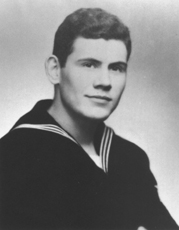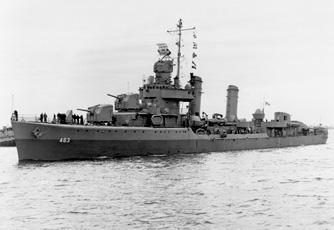Early in the spring of 1944, I and about 20 other radio technicians from the Atlantic Fleet destroyers
were sent to a Navy electronics lab in Cambridge Massachusetts. There, we
learned that German radio missiles had become a serious threat to Allied
ships in the Mediterranean Sea. We learned that a German bomber could
carry two missiles which were gliders with warheads and radio-controlled
tail surfaces. German pilots would approach ships, and while still out of
range of the ship’s guns, would direct their planes toward the ships and
release missiles. As a missile dropped away from a plane, a brief rocket
charge in the missile would accelerate it to about 300 mph. Then the German
pilot, with his radio controls, had about 30 seconds to guide his missiles
into a ship. There was great concern because these missiles were causing
considerable damage to Allied ships in the Mediterranean and there was no
effective defense.
A team from the electronics lab
had gone to the Mediterranean to study the menace. They observed the German
medium bombers in action. They filmed activity, recorded signals and brought
back an unexploded missile and the electronic control box from a bomber that
had crashed in shallow water. The research team noted that the German pilots
would switch on the missile controls to warm up the vacuum tubes and observe
the operation of the missile control surfaces long before they were in the
target area. The countermeasure developed by the electronics lab was a
special tuner that controlled both a receiver and a transmitter. The
sensitive receiver could be sharply tuned to the German missile frequency.
The signal from a German plane testing a missile while approaching a ship
could be detected from a maximum range of about 30 miles. When the
characteristic signal from the plane indicated that the missile had been
dropped, the jamming equipment was switched from RECEIVE to TRANSMIT and a
powerful signal from the transmitter could take control of the missile and
spin it into the sea.
Technicians from the navy
electronics lab helped me install and test the new secret jamming
equipment. A 3-foot whip antenna was mounted on the forward side of the
number 2 stack and a coax cable was run down into the engineering log room.
Engineering officer Chechames put up a major objection to locating this
equipment in his small crowded room. However, that’s where it had to go. One
metal chassis was secured to the top of a file cabinet and an aircraft type
tuner was mounted to the forward bulkhead beside the desk.
A few months later, the Corry,
surrounded by hundreds of other ships, was crossing the English Channel. As
I looked out at the large armada of ships I began to realize the
importance of the missile jamming equipment for which I was responsible. I
felt confident that the equipment would work and that I knew how to operate
it to knock out the German missiles. Many hours were spent listening for
German missile signals during the long, slow Channel crossing. I was set
up to communicate with the bridge and to log signals but none were heard.
Early on the morning of June 6th
the tuning and listening operation ended with a terrific explosion. I,
my chair, the desk, file cabinets and everything in the room were thrown up
into the air. I hit my head and shoulder on the overhead and came back
down on the aluminum chair. The chair broke so I was setting on the deck
with my legs under the desk and the seat of the chair still under me.
After a few blank minutes, B.J. Petersen stuck his head in the door and
said, “Are you alright?” I was too dazed to know, so Petersen helped me
to my feet and we went out on deck. I didn’t know what had happened –
there was orderly confusion, but no panic. Everyone on deck seemed to be
busy getting injured people into lifeboats and helping shipmates that needed
help.
I made my way up to the
Combat Information Center where I found my boss, Chief McKernon. Mac said
we had been hit by shore batteries and all ship’s power was lost. The word
was out to abandon ship so Mac had activated the built-in incendiaries to
destroy the radars. Mac said we had better go to our abandon-ship stations.
I met my friend Pete McHugh, a radar operator, on the main deck. Most of
the crew was now off the ship and the danger of staying aboard was
increasing. The Corry was bending amidships as the below deck
compartments filled with seawater and the shore batteries were still firing.
However, Pete and I decided to delay just a little longer in the hope of
getting into a lifeboat rather that the cold water, but it didn’t work. A
young officer came along and thought we were frightened. He put an arm
around each of us and said, “Men, we’re going to be alright – Let’s all go
into the water together.” The three of us just stepped in amidships where
the water was already knee-deep. We swam away from the ship about 50 yards
before inflating our life belts and then turned around to take a last sad
look at our ship. We stopped complaining about the cold water when
another German shell hit the ship. Then a shell hit the smoke-laying
equipment on the fantail and we were engulfed in smoke that made breathing
difficult for a few minutes and the three of us became separated.
About two hours later a PT boat
came along and took me aboard. I was later put aboard the Corry’s
sister ship, the USS Fitch (DD-462). On the Fitch, I got
some dry clothes from the ship’s laundry. After a sandwich and coffee I
went to the Combat Information Center to see my friend from navy
electronics school, named Damasse. About an hour later, the many Corry
survivors were transferred from the Fitch to the USS Barnett,
a troop transport that was completing the unloading of invasion troops.
After a hot meal and a good night’s rest, I woke early the next morning
in a port in Southern England.


Bill Beat
Radio Technician, 2nd class, USS Corry
(DD-463)
On the Morning of June 6, 1944,
aboard the destroyer USS Corry (DD-463) at Utah Beach, Normandy, my normal battle station would have been in the Combat Information
Center (CIC). I would usually be standing by to assist Chief McKernon in
making sure that all radars, sonars, and other electronic equipment were
operating properly. However, this day the Corry was involved in a
special operation and I had been trained for a special assignment. I was
in the engineering log room, on the main deck level, operating a new
electronic device for jamming German radio guided missiles.
Radio Technician, 2nd class
USS Corry
(DD-463)